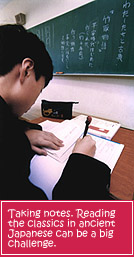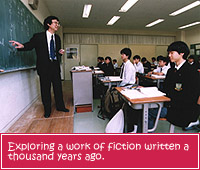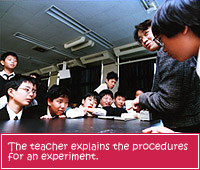 Most students commute by train, so the streets from the station to the school are a sea of navy and gray uniforms in the morning. Kids either bring their own lunches or eat in the cafeteria, and after school, many participate in club activities. |
Kanagawa
University High School
|
|
|
|
||
|
The School Day |
||
 "It's
really remarkable," says Mr. Hayashi, "that Japanese kids today
can read something that was written so long ago and basically understand
it. Through literature, ancient Japanese people's attitudes and their
conception of nature continue to influence people today."
"It's
really remarkable," says Mr. Hayashi, "that Japanese kids today
can read something that was written so long ago and basically understand
it. Through literature, ancient Japanese people's attitudes and their
conception of nature continue to influence people today."Seventh and eighth graders are required to memorize and recite passages from classical Japanese literature. |
||
| Class
2:
Science
|
||
 "I don't like tests that
much," confesses one student, "but I really like doing experiments."
Some students make a fuss during the experiment ("Hey! I can't see
the light!"), but everyone has a lot of fun, and the 50-minute period
passes quickly. Even after the end-of-class bell rings, several students
remain absorbed in their experiments.
"I don't like tests that
much," confesses one student, "but I really like doing experiments."
Some students make a fuss during the experiment ("Hey! I can't see
the light!"), but everyone has a lot of fun, and the 50-minute period
passes quickly. Even after the end-of-class bell rings, several students
remain absorbed in their experiments.
|
||
|
|
||

 Let's
visit the Japanese class for seventh grade class E. The teacher, Nobuki
Hayashi, is introducing his students to an ancient Japanese classic,
Taketori monogatari ("The Tale of the Bamboo Cutter"),
which was written more than a thousand years ago. This makes it the
oldest existing work of fiction in the Japanese language. Among other
things, the
Let's
visit the Japanese class for seventh grade class E. The teacher, Nobuki
Hayashi, is introducing his students to an ancient Japanese classic,
Taketori monogatari ("The Tale of the Bamboo Cutter"),
which was written more than a thousand years ago. This makes it the
oldest existing work of fiction in the Japanese language. Among other
things, the Now
it's time for science class, where students enjoy using various pieces
of equipment to do experiments. Today, seventh grade class D is performing
an experiment that concerns the diffraction of light. After the teacher,
Chieko Nakayama, explains the procedure to the class, the class divides
up into nine groups to do the experiment. Using a device made of cardboard
and a flashlight, the groups observe light shining through different-shaped
pieces of glass--a trapezoid, a simple circle, and a lens--and note
the directions in which the light bends.
Now
it's time for science class, where students enjoy using various pieces
of equipment to do experiments. Today, seventh grade class D is performing
an experiment that concerns the diffraction of light. After the teacher,
Chieko Nakayama, explains the procedure to the class, the class divides
up into nine groups to do the experiment. Using a device made of cardboard
and a flashlight, the groups observe light shining through different-shaped
pieces of glass--a trapezoid, a simple circle, and a lens--and note
the directions in which the light bends.